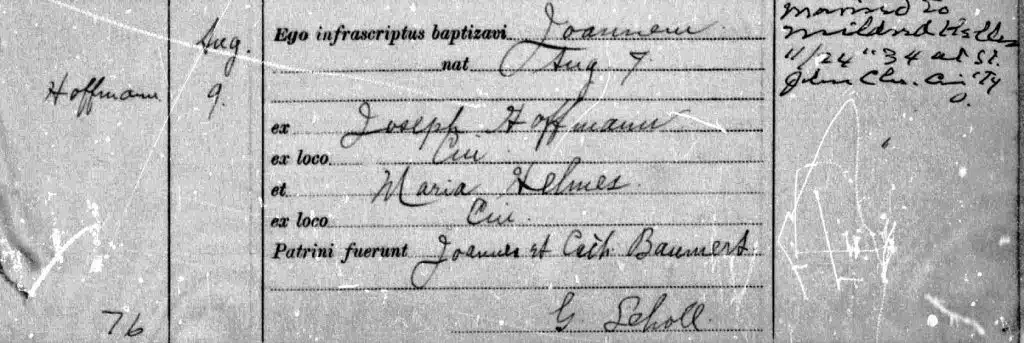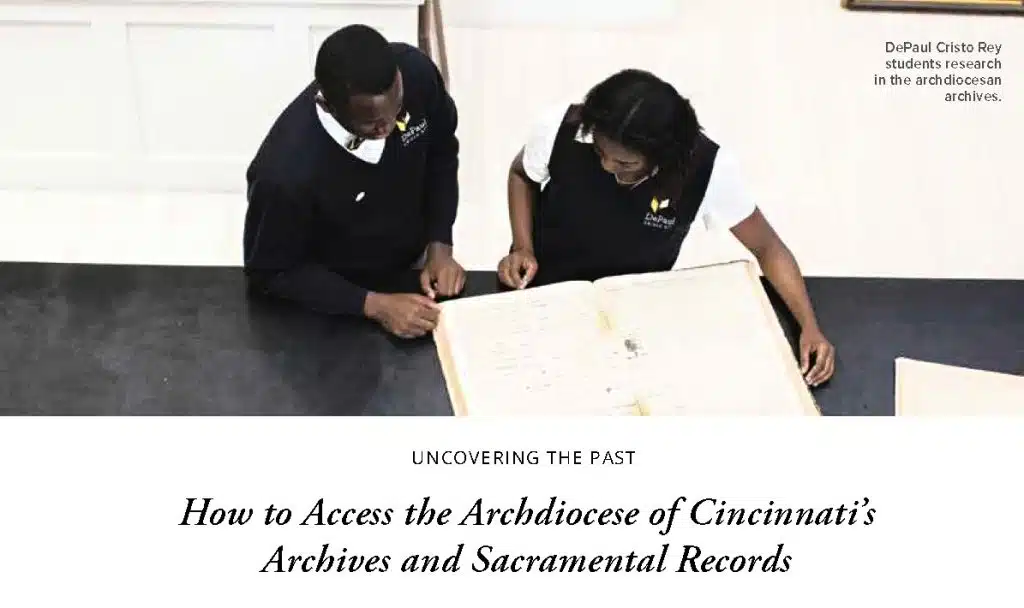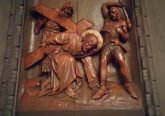How to Access the Archdiocese of Cincinnati’s Archives and Sacramental Records
This column previously explained researching and documenting your ancestors. Now, it’s time to delve into genealogical resources at the Archdiocese of Cincinnati’s Archives (resources.catholicaoc.org/offices/archives).
GENEALOGY RESOURCES
Sacramental records are one component of the archdiocesan archives. To protect privacy, baptism and marriage records are closed for 100 years after sacramental reception; however, death records before 1953 are available. These records are available online at Find My Past, which offers a seven-day free trial, or by request from the archdiocesan archives, for a nominal fee.
With both methods, be prepared with the following information regarding the sacrament: recipient’s name and possible address; and the date and parish of sacrament’s reception.\
Information that can be found in a sacramental record:
Baptism/Confirmation: Recipient’s name, date of birth, date of baptism or confirmation and parents’ names; names of witnesses or sponsors, priest and parish.
Marriage: Groom’s name, bride’s maiden name, date of marriage and names of witnesses and priest. This information is often annotated on the person’s baptism record.
Death/Burial: Person’s name, date of death, place of interment and sometimes age or cause of death. The archives also lists cemeteries used by Catholics.
 Sample birth / marriage record.
Sample birth / marriage record.
Archdiocese of Cincinnati archivist, Michelle Smith, said most of their archives are in Latin, with some in German, particularly the older documents. However, the archives’ genealogy section provides a helpful list of common Latin terms, including father (pater), mother (mater), witnesses (testes) and where (ubi).
MAPS AND PARISH HISTORIES
This section of the genealogy archives contains maps and early parishes’ founding histories. Census records can reveal the streets where ancestors once lived, which might be listed on an archived map.
1818 – Initially outside the city limits of Cincinnati on Liberty and Vine Streets, Christ Church was in the diocese of Bardstown, KY. After Cincinnati was made a diocese on June 19, 1821, the church building was moved, in 1822, to Sycamore St. and became the archdiocese’s cathedral as St. Peter in Chains Cathedral. It was again renamed, to St. Francis Xavier, when the newly built church at Eighth and Plum Streets became the archdiocese’s cathedral as St. Peter in Chains Cathedral.
1838 – The first map of archdiocesan parishes. Maps of parishes include Cincinnati, St. Martin, St. Augustine in Minster and St. John in Maria Stein—to name a few.
DIGITAL COLLECTIONS
In addition to sacramental resources, the archdiocesan archives holds a vast digital collection, chiefly past issues of The Catholic Telegraph. Founded in 1831, the newspaper’s first 100 years (1831-1930) were digitized and are found online at the Catholic News Archive (CRRA). The newspaper archive is also available through the Public Library of Cincinnati and Hamilton County (1847-2012).
RECORDS MANAGEMENT
Archives staff are another valuable resource, guiding parishes and offices regarding record retention policy, the sacramental records handbook and quick tips for permanent and non-permanent records.
NEXT UP: Creating a Genealogy Timeline
 Ruthy Trusler is a communication consultant with a passion for genealogy. For over 20 years, she has helped families document their ancestry and write their family legacies
Ruthy Trusler is a communication consultant with a passion for genealogy. For over 20 years, she has helped families document their ancestry and write their family legacies
This article appeared in the July 2024 edition of The Catholic Telegraph Magazine. For your complimentary subscription, click here.














